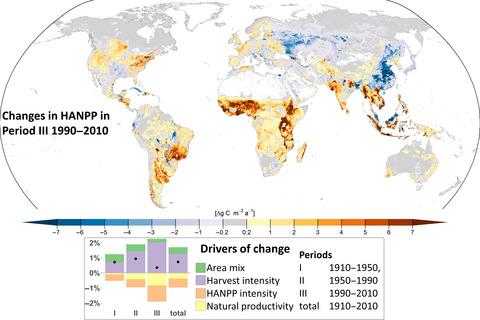当前位置:
X-MOL 学术
›
Glob. Change Biol.
›
论文详情
Our official English website, www.x-mol.net, welcomes your
feedback! (Note: you will need to create a separate account there.)
Land use intensification increasingly drives the spatiotemporal patterns of the global human appropriation of net primary production in the last century
Global Change Biology ( IF 10.8 ) Pub Date : 2021-10-14 , DOI: 10.1111/gcb.15932 Thomas Kastner 1, 2 , Sarah Matej 2 , Matthew Forrest 1 , Simone Gingrich 2 , Helmut Haberl 2 , Thomas Hickler 1, 3 , Fridolin Krausmann 2 , Gitta Lasslop 1 , Maria Niedertscheider 2, 4 , Christoph Plutzar 2, 5 , Florian Schwarzmüller 1 , Jörg Steinkamp 1, 6 , Karl-Heinz Erb 2
Global Change Biology ( IF 10.8 ) Pub Date : 2021-10-14 , DOI: 10.1111/gcb.15932 Thomas Kastner 1, 2 , Sarah Matej 2 , Matthew Forrest 1 , Simone Gingrich 2 , Helmut Haberl 2 , Thomas Hickler 1, 3 , Fridolin Krausmann 2 , Gitta Lasslop 1 , Maria Niedertscheider 2, 4 , Christoph Plutzar 2, 5 , Florian Schwarzmüller 1 , Jörg Steinkamp 1, 6 , Karl-Heinz Erb 2
Affiliation

|
Land use has greatly transformed Earth's surface. While spatial reconstructions of how the extent of land cover and land-use types have changed during the last century are available, much less information exists about changes in land-use intensity. In particular, global reconstructions that consistently cover land-use intensity across land-use types and ecosystems are missing. We, therefore, lack understanding of how changes in land-use intensity interfere with the natural processes in land systems. To address this research gap, we map land-cover and land-use intensity changes between 1910 and 2010 for 9 points in time. We rely on the indicator framework of human appropriation of net primary production (HANPP) to quantify and map land-use-induced alterations of the carbon flows in ecosystems. We find that, while at the global aggregate level HANPP growth slowed down during the century, the spatial dynamics of changes in HANPP were increasing, with the highest change rates observed in the most recent past. Across all biomes, the importance of changes in land-use areas has declined, with the exception of the tropical biomes. In contrast, increases in land-use intensity became the most important driver of HANPP across all biomes and settings. We conducted uncertainty analyses by modulating input data and assumptions, which indicate that the spatial patterns of land use and potential net primary production are the most critical factors, while spatial allocation rules and uncertainties in overall harvest values play a smaller role. Highlighting the increasing role of land-use intensity compared to changes in the areal extent of land uses, our study supports calls for better integration of the intensity dimension into global analyses and models. On top of that, we provide important empirical input for further analyses of the sustainability of the global land system.
中文翻译:

上个世纪,土地利用集约化日益驱动全球人类对净初级生产的占有的时空格局
土地利用极大地改变了地球表面。虽然可以获得关于上个世纪土地覆盖范围和土地利用类型如何变化的空间重建,但关于土地利用强度变化的信息却很少。尤其是,缺少始终涵盖跨土地利用类型和生态系统的土地利用强度的全球重建。因此,我们对土地利用强度的变化如何干扰土地系统中的自然过程缺乏了解。为了弥补这一研究空白,我们绘制了 1910 年至 2010 年 9 个时间点的土地覆盖和土地利用强度变化图。我们依靠人类对净初级生产的占用(HANPP)的指标框架来量化和绘制土地利用引起的生态系统中碳流动的变化。我们发现,虽然在本世纪全球总体水平上 HANPP 增长放缓,但 HANPP 变化的空间动态正在增加,最近观察到的变化率最高。在所有生物群落中,除热带生物群落外,土地利用区域变化的重要性已经下降。相比之下,土地利用强度的增加成为所有生物群落和环境中 HANPP 的最重要驱动因素。我们通过调整输入数据和假设进行了不确定性分析,这表明土地利用的空间格局和潜在的净初级生产是最关键的因素,而空间分配规则和总体收获价值的不确定性发挥的作用较小。强调与土地利用面积范围的变化相比,土地利用强度的作用越来越大,我们的研究支持将强度维度更好地整合到全球分析和模型中的呼吁。最重要的是,我们为进一步分析全球土地系统的可持续性提供了重要的经验输入。
更新日期:2021-12-03
中文翻译:

上个世纪,土地利用集约化日益驱动全球人类对净初级生产的占有的时空格局
土地利用极大地改变了地球表面。虽然可以获得关于上个世纪土地覆盖范围和土地利用类型如何变化的空间重建,但关于土地利用强度变化的信息却很少。尤其是,缺少始终涵盖跨土地利用类型和生态系统的土地利用强度的全球重建。因此,我们对土地利用强度的变化如何干扰土地系统中的自然过程缺乏了解。为了弥补这一研究空白,我们绘制了 1910 年至 2010 年 9 个时间点的土地覆盖和土地利用强度变化图。我们依靠人类对净初级生产的占用(HANPP)的指标框架来量化和绘制土地利用引起的生态系统中碳流动的变化。我们发现,虽然在本世纪全球总体水平上 HANPP 增长放缓,但 HANPP 变化的空间动态正在增加,最近观察到的变化率最高。在所有生物群落中,除热带生物群落外,土地利用区域变化的重要性已经下降。相比之下,土地利用强度的增加成为所有生物群落和环境中 HANPP 的最重要驱动因素。我们通过调整输入数据和假设进行了不确定性分析,这表明土地利用的空间格局和潜在的净初级生产是最关键的因素,而空间分配规则和总体收获价值的不确定性发挥的作用较小。强调与土地利用面积范围的变化相比,土地利用强度的作用越来越大,我们的研究支持将强度维度更好地整合到全球分析和模型中的呼吁。最重要的是,我们为进一步分析全球土地系统的可持续性提供了重要的经验输入。











































 京公网安备 11010802027423号
京公网安备 11010802027423号